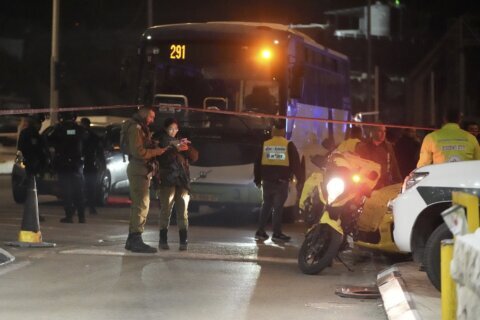When she first heard about the evacuation warnings Israel was sending to residents of Lebanon, Aline Naser’s thoughts immediately turned to Gaza.
For the past year, the 26-year-old Beirut resident has been following with horror the reports about besieged Palestinians in the Gaza Strip ordered to move from one place to the other, fleeing to “humanitarian zones” only to be bombed and ordered to leave again.
The Israeli calls for Lebanese citizens to evacuate ahead of a widening air campaign, delivered via mobile phone alerts, calls and leaflets this week, seemed chillingly familiar.
“It’s definitely something on the back of my mind, and we don’t really know where exactly is safe,” she said.
Almost a year after the start of its war in Gaza, Israel has turned its focus on Lebanon, significantly ratcheting up its campaign against its archenemy Hezbollah. Among many in Lebanon, there is fear that Israel’s military operations in Lebanon would follow the same Gaza playbook: Evacuation orders, mass displacement and overwhelming airstrikes. Israel says its strikes target Hezbollah weapons sites and militants.
There are key differences between Gaza and Lebanon and how Israel has so far conducted its operations, which it says aim to push back Hezbollah from the border so that tens of thousands of Israelis displaced by Hezbollah’s rocket attacks can return to their homes. Although it has said it is preparing for a possible ground operation, Israel has so far not sent troops into Lebanon.
Still, there are fears that Israel’s actions in Gaza, including the use of overwhelming and what rights groups and the United Nations have described as disproportionate force, would be repeated in Lebanon. Top Israeli officials have threatened to repeat the destruction of Gaza in Lebanon if the Hezbollah fire continues.
On Monday, Israel struck 1,600 targets across Lebanon, killing 492 people and wounding 1,645, and causing a massive wave of displacement as thousands fled from south Lebanon north. It was a staggering one-day toll that shocked a nation used to war. It was by far the deadliest barrage since the monthlong 2006 Israel-Hezbollah war, when an estimated 1,000 people in Lebanon were killed.
Throughout the day, the Israeli military sent warnings to residents to immediately evacuate in anticipation of the strikes and to stay away from places where Hezbollah stores weapons — something most would have no way of knowing.
“Please get out of harm’s way now,” Israeli Prime Minister Benjamin Netanyahu said in a recorded message. “Once our operation is finished, you can come back safely to your homes.”
Israel’s evacuation orders have been a central part of its military campaign in Gaza for the past year. In the first week after launching war, Israel ordered 1.1 million civilians in the Gaza Strip to relocate from the north to the south, sowing confusion and fear in the overcrowded enclave.
Since then, the Israeli military has issued dozens of evacuation orders calling on Palestinians to evacuate to Israeli-designated “humanitarian zones.” Israeli officials say they are targeting Hamas militants who have embedded themselves among the population. Israel’s campaign in Gaza has killed more than 41,000 Palestinians, according to health officials in Gaza. The Health Ministry, part of the territory’s Hamas government, does not differentiate between civilians and combatants, but says that just over half the dead have been women and children.”
With Gaza’s borders sealed, residents of the crammed territory are trapped with nowhere to go, whereas in Lebanon, those fleeing Israeli strikes have been able to move to safer areas. Thousands have fled to neighboring Syria, while others have left through the country’s airport.
A second front for Israel
Hezbollah started firing rockets on Israel in support of Gaza on Oct. 8, a day after Hamas militants launched an unprecedented attack on Israel, killing some 1,200 people and abducting another 250. Since then, the two sides have been engaged in cross border strikes that have gradually escalated and displaced tens of thousands of civilians on both sides of the border.
Many Lebanese have been following the growing hostilities with a mixture of nonchalance and dread, hoping they would remain contained. Lebanon has been in the throes of an economic meltdown since 2019 and can ill afford another devastating war with Israel.
Hostilities escalated dramatically last week when thousands of explosives hidden in pagers and walkie-talkies used by Hezbollah detonated, killing dozens of people and leaving thousands, including many civilians, with severe injuries to the eyes, face and limbs. Israel is widely believed to be behind the attack. Israel has also killed several top Hezbollah commanders in Beirut.
Meanwhile, intensifying Hezbollah barrages have wounded several people in Israel.
As the region appeared to be teetering toward another all-out war, Jana Bsat, 25, who works for a media analysis company in Beirut, said she now has a bag packed, ready for immediate evacuation. She feels it’s only a matter of time.
“It feels surreal, to be honest. We heard about what was happening in Gaza and now we’re experiencing it for ourselves,” she said.
“I am in disgust of all this fear-mongering and psychological torture,” she said, adding: “But then you remember, it’s all part of a warfare strategy and it’s not going to stop anytime soon.”
Lebanon is not Gaza
While Israel’s actions in Lebanon may have echoes of Gaza, the conflicts are different. In Gaza, Israel’s goal is the complete destruction of Hamas, whereas Israel’s stated goal in Lebanon is to push Hezbollah away from its border. Whereas Hamas rules Gaza, Hezbollah is a powerful militia with enormous influence inside Lebanon, and has representatives in the country’s parliament and government.
In 2006, Israel flattened entire Beirut neighborhoods and bombed Lebanon’s only international airport as well as key infrastructure, including bridges and power stations. By contrast, its current campaign seems to be, for the large part, targeting Hezbollah, although many civilians have also been killed.
Unlike Gaza, Lebanon is also a mixed tapestry of political and religious groups, including Christian and Sunni-majority areas where there is significant opposition to the Iran-backed Shiite Hezbollah.
Ali Safa, a 30-year-old interior designer who fled to Beirut from south Lebanon with his family this week, said he isn’t worried about the Gaza scenario being repeated in Lebanon.
“Gaza is an open prison, it is besieged. Lebanon is much larger, it is not encircled. And it has Hezbollah, which is a much bigger force, much better-equipped than Hamas,” he said.
U.N. Secretary General Antonio Guterres, speaking at the United Nations Wednesday, said the world “cannot afford Lebanon to become another Gaza.”
Frayed nerves
Whether the current hostilities will expand into an all-out war or whether Israel will launch a ground invasion remains to be seen. Israel’s army chief said Wednesday that preparations were underway for a possible ground operation.
Many in Lebanon say they are haunted by the nonstop churn of horrifying images from Gaza over the past year, fearing the same scenario in Lebanon.
For several months, low-flying Israeli fighter jets have launched sonic booms over Lebanon, rattling windows and terrifying residents. More recently, the buzzing sound of Israeli military drones in Lebanese skies have added to the anxiety.
Some have gotten used to it. At a funeral for a Hezbollah commander recently where a few hundred people gathered, hardly anyone flinched when low-flying Israeli planes caused a thundering boom that shook the ground.
Bsat said at some point she, too, got used to hearing sonic booms that made the windows in her house shake.
“The drones I also got used to and now, unfortunately, the bombing,” she said via Whatsapp.
“I’ve come to terms with reality, but my hands still can’t stop shaking as I’m writing this,” she said.
“I’m still dreading what is going to happen here.”
Copyright © 2024 The Associated Press. All rights reserved. This material may not be published, broadcast, written or redistributed.






